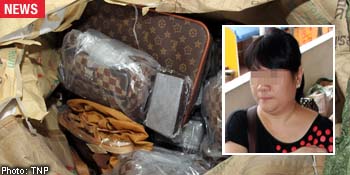- Joined
- Apr 9, 2009
- Messages
- 3,070
- Points
- 0

SHE was the HDB copy auntie.
For a few years, she peddled a range of counterfeit branded bags in the heartlands.
Operating alone, she would turn up early and set up her makeshift stall, but always only for a day, just to avoid detection.
Last Friday at 6am, police officers caught the 37-year-old Singaporean at the carpark of a flatted factory in Toa Payoh.
After her arrest, she led police to a warehouse in Block 1008, Toa Payoh North, where she had been storing the bags.
She also took police to a warehouse in Bukit Batok where more bags were recovered.
In the seven-hour operation, police seized about 2,300 counterfeit bags worth about $81,000.
The knock-offs in the warehouse included luxury brands such as Gucci, Louis Vuitton, Salvatore Ferragamo, Burberry and Fendi.
She also stocked other brands including Hello Kitty and Coach.
The New Paper was there during the raid.
The bags were poorly stitched and had badly printed logos on them.
In a bid to make the goods look more authentic, some wallets were kept in red boxes bearing the Salvatore Ferragamo brand logo.
Some handbags even had their own dust bags.
Police had received a tip-off and had monitored the woman's movements for some time before moving in.
The New Paper understands the woman had been renting the unit in the flatted factory to store her goods since 2004.
She ran a one-person operation, starting her day at 6am.
She would load the bags onto a van, drive to a location in the heartlands - such as Jurong East, Ang Mo Kio or Woodlands - and set up her stall.
She had to pay about $50 in rent to set up her stall outside the shopfronts of other units on the ground floor of HDB blocks.
Customers
Her customers included housewives and maids, who would fork out $2 to $35 for the bags and wallets which she had bought for between 40 cents and $20.
The bags were supplied to her by contacts working in factories in Guangzhou and Shenzhen in China, and were imported into Singapore by courier.
She would pack up between 1pm and 3pm, depending on how brisk business was for the day.
Business was good, it seems.
She sold an average of 10 bags an hour, making more than $150 a day.
In some weeks, she would earn as much as $2,000.
She even provided catalogues at her stall and would take orders from customers who wanted certain models that she did not have.
A police spokesman said police will continue to take strict enforcement action against pirates who profit at the expense of legitimate business and consumers.
Persons found guilty of selling or distributing infringing articles of any work in which copyright subsists, may be fined up to $10,000 per article, up to a total maximum fine of $100,000, or imprisoned for up to five years or both, he added.
Mr Aaron Chua, 34, owner of the Interesthing Shop at the Adelphi, which buys and sells second-hand designer bags, described ways to spot a fake bag.
Besides distorted logos, fakes go cheap on the zippers, the lining in the bag and the stitching.
Mr Chua, who has been in the industry for five years, said: "The biggest giveaway would be the material used to make the bags. If the straps are made of PVC, they are obviously fake.
"For Louis Vuitton bags, the straps are mostly made of cow-hide leather."
He also said the zippers on Gucci bags would either be made by YKK or have the Gucci logo on the zipper.
There are websites such as www.mypoupette.com and www.ilvoelv.com which provide tips on identifying the real McCoy, he added.
Mr Chua said some people go to his shop in the hope of selling their second-hand bags, unaware that they are fakes.
This year, he has seen some 10 such cases.
He said: "Some of them even have receipts with them. They bought their bags from Europe and just because they have a receipt, they think it's real.
"They never realised that their bag was a fake."
This article was first published in The New Paper.



